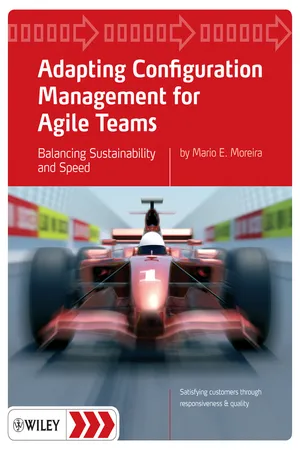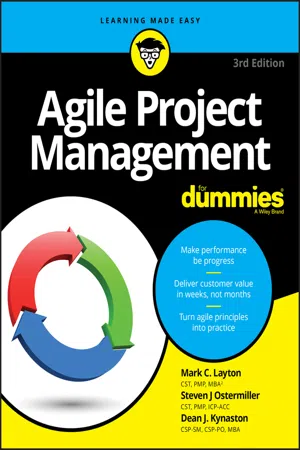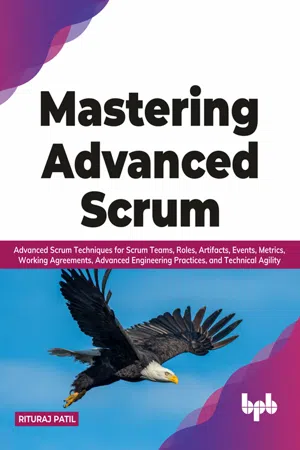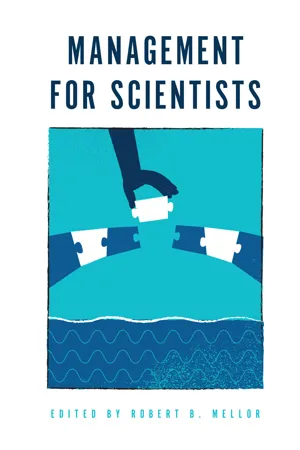Computer Science
Agile Methodology
Agile methodology is a software development approach that emphasizes flexibility, collaboration, and iterative development. It prioritizes customer feedback and adapts to changing requirements throughout the development process. Agile methodologies, such as Scrum and Kanban, promote continuous improvement and aim to deliver high-quality software in a more efficient and responsive manner.
Written by Perlego with AI-assistance
Related key terms
10 Key excerpts on "Agile Methodology"
- eBook - ePub
Adapting Configuration Management for Agile Teams
Balancing Sustainability and Speed
- Mario E. Moreira(Author)
- 2010(Publication Date)
- Wiley(Publisher)
CHAPTER 3Agile PrimerAgile methods for software development are one of the hottest changes in the methodology field. Agile is an umbrella term that includes various approaches, methods, and techniques that use short iterations and continuous customer feedback so that the project team can evolve the customer need (a.k.a., product). What the customer sees as progress is not the standard documents and status reports but instead tangible working product functionality. This approach allows the customer to reconsider and adjust their need until it is transformed into a valuable working product. Progress is not considered until a piece of functionality is built. Functionality equates to a value to the customer. This ultimately means delivering business value (what the customer really wants). Of course this implies that you have to continuously work with the customer to get there.Agile methods provide a means of adapting quickly for teams facing unpredictable or rapidly changing requirements. Agile introduces a structured approach to software development to ensure the customer gets early and periodic views of their solution for continuous feedback, more assurance that they are getting a solution that solves their business need, and a working solution in typically a shorter time frame.Implementing Agile methods impacts the culture because it relies on more than just implementing a process or new practices. Instead the organization needs to move away from the hierarchical command and control model, which includes ceremony (i.e., protocol) and requires approvals from the top down, and instead move to a more heterarchical world of a self-empowering team model moving empowerment and decision making to the lowest possible level, where most of the relationships and relevant data are present to make the best decision. - eBook - ePub
Going Beyond the Waterfall
Managing Scope Effectively Across the Project Life Cycle
- Barbara Davis, Darren Radford(Authors)
- 2014(Publication Date)
- J. Ross Publishing(Publisher)
SECTION 3: APPLYING PROJECT AND ARCHITECTURE METHODOLOGIESPassage contains an image IMPLICATIONS OF AGILE ON SCOPE
There is increasing pressure on organizations to deliver working solutions to business in ever-shorter timescales without compromising quality. The processes by which solutions are developed must be agile and deliver what the business needs, when it needs it.WHAT IS AGILE?In this context, Agile development is a group of methods that provides a flexible yet controlled process that can be used to deliver solutions. Historically, the development methods have been applied to software development, but agile methods can be used for initiatives that have no technology element at all.In the project context, Agile is a delivery method based on iterative, incremental, and evolutionary development and delivery principles, as originally defined by Watts Humphries (IBM) and Hadar Ziv (University of California). It was designed as a means to deliver blocks of usable functionality in increments through short development and delivery cycles, typically called “sprints.” This “speed of delivery” represents one key differentiator between the traditional, sequential methodology known as “Waterfall.” Agile principles consider requirements as uncertain and even indefinable until the end user has had the chance to work with the solution, with both requirements and the solution evolving through collaboration as the project progresses. “Uncertainty is inherent and inevitable in software development processes and products.”1 By delivering blocks of functionality in each sprint, the end users then have the opportunity to work with and comment on the product as it is being developed and refined.Each sprint is directed by a person called a “scrum master,” and can be anywhere from two to four weeks in duration. Figure 7.1 - eBook - ePub
- Mark C. Layton, Steven J. Ostermiller, Dean J. Kynaston(Authors)
- 2020(Publication Date)
- For Dummies(Publisher)
The Agile Manifesto and the agile principles on their own wouldn’t be enough to launch you into agile product development, eager as you might be to do so. The reason is that principles and practices are different. The approaches described in this book, however, provide you with the necessary practices to be successful.Agile is a descriptive term for a number of techniques and methods that have the following similarities:- Demonstrating valuable and potentially shippable functionality in short iterations called iterative development
- Emphasis on simplicity, transparency, and situation-specific strategies
- Cross-functional, self-organizing teams
- Working functionality as the measure of progress
- Responsiveness to changing requirements
Synonyms of the word agile — including resilient, flexible, nimble, adaptive, lightweight, and responsive — give additional insights into what it means to be agile.Similarly, throughout this book, we reference agile teams. Agile teams, which include scrum teams (scrum being the most popular agile framework), are teams who adhere to the agile values and principles to become more resilient, flexible, nimble, adaptive, lightweight, and responsive in meeting their customer’s needs.Agile product development is an empirical approach. In other words, you do something in practice and adjust your approach based on experience rather than theory. With regards to product development, an empirical approach is braced by the following pillars:- Unfettered transparency: Everyone involved in the process understands and can contribute to the development of the process.
- Frequent inspection: The inspector must inspect the product regularly and possess the skills to identify variances from acceptance criteria.
- Immediate adaptation: The development team must be able to adjust quickly to minimize further product deviations.
A host of approaches have agile characteristics. Three, however, are commonly used: lean product development, scrum, and extreme programming (XP). These three approaches work perfectly together and share many common elements, although they use different terminology or have a slightly different focus. Broadly, lean and scrum focus on structure. Extreme programming does that, too, but is more specific about development practices, focusing more on technical design, coding, testing, and integration. (From an approach called extreme programming, - eBook - ePub
Hands-On Software Engineering with Python
Move beyond basic programming and construct reliable and efficient software with complex code
- Brian Allbee(Author)
- 2018(Publication Date)
- Packt Publishing(Publisher)
- Build projects around motivated individuals. Give them the environment and support they need, and trust them to get the job done.
- The most efficient and effective method of conveying information to and within a development team is face-to-face conversation.
- Working software is the primary measure of progress.
- Agile processes promote sustainable development. Sponsors, developers, and users should be able to maintain a constant pace indefinitely.
- Continuous attention to technical excellence and good design enhances agility.
- Simplicity—the art of maximizing the amount of work not done—is essential.
- The best architectures, requirements, and designs emerge from self-organizing teams.
- At regular intervals, the team reflects on how to become more effective, then tunes and adjusts its behavior accordingly.
You may refer to The Agile Manifesto at http://Agilemanifesto.org/ for more details.In an application, these principles lead to a few common characteristics across different methodologies. There may be exceptions in other methodologies that are still considered Agile, but for our purposes, and with respect to the specific methodologies discussed here, those common traits are as follows:- Development happens in a sequence of iterations, each of which has one to many goals
- Each goal is a subset of the final system
- At the conclusion of each iteration, the system is deployable and operational (perhaps only for a given value of operational)
- Requirements are defined in detail in small chunks, and may not be defined at all until just before the iteration that they're going to be worked on
Scrum is claimed to be the most popular, or at least most widely used, Agile development methodology (the12th Annual Stateof Agile Report - eBook - ePub
Mastering Software Project Requirements
A Framework for Successful Planning, Development & Alignment
- Barbara Davis(Author)
- 2013(Publication Date)
- J. Ross Publishing(Publisher)
SECTION IV APPLYING PROJECT AND ARCHITECTURE METHODOLOGIESPassage contains an image Implications of Agile on Requirements
Agile is an iterative process for the software development life cycle. It was intended to deliver functionality in small increments within shorter time frames than more traditional life cycles. It is based upon the principles put forward by Watts Humphries of IBM and Hadar Ziv of the University of California that requirements are uncertain until people have had the chance to work and play with the solution.“Uncertainty is inherent and inevitable in software development processes and products.”1The Agile process runs in short iterations, called “sprints,” and each sprint is guided by a person in the role of a “scrum master.” These sprints can be anywhere from two to four weeks. Figure 10.1 illustrates the agile process.The Agile process begins with the road map to value. This road map provides a high-level view of the overall project and identifies several stages that will enable the project to progress from concept to product in a clearly defined manner. These stages are product vision, product road map, release plan, sprint planning, sprint review, and the sprint retrospective. Figure 10.2 illustrates the agile road map to value.In the first stage (also known as initial planning), the product vision is defined in collaboration with the product owner. This vision clearly defines the product, how it will support the business and its strategy, as well as who will use the product, and how this product will be used.In the second stage (also known as planning), the product road map is defined in collaboration with the scrum master and the product owner. This road map provides a high-level view of the requirements, with a rough time frame for developing and delivering those requirements. The road map is only effective when it contains details about the product and the effort required to develop and implement this product. In this case, these details include requirements, prioritization of those requirements, and an estimation of the effort to develop and implement those specific requirements. - eBook - ePub
Mastering Advanced Scrum
Advanced Scrum Techniques for Scrum Teams, Roles, Artifacts, Events, Metrics, Working Agreements, Advanced Engineering Practices, and Technical Agility
- Rituraj Patil(Author)
- 2021(Publication Date)
- BPB Publications(Publisher)
Manifesto for Agile Software Development . This needs to be united with the principles of Lean to rapidly deliver the working software. Lean is a management philosophy based on practices at Toyota Systems, which is described by a structure of processes. Lean has expectations from teams to reduce risks and wastes enhancing customer value, where this structure needs to be formed.Software development teams also need to have a Lean Agile Mindset. It is a combination of various behavioral aspects of teams considering their principles, beliefs, feelings, opinions, and actions embracing both Manifesto for Agile Software Development and Lean Agile Thinking . All the team members need to have a growth mindset based Lean Agile Thinking to try out the new things, to challenge themselves to grow, to take failures as opportunities to continuously learn, unlearn, and re-learn, to inspire others and to get inspired from others, to have a positive outlook for out of the box thinking, and to challenge themselves by always seeking continuous improvement.Figure 2.7: Lean Agile Software Product Development ApproachThe term Lean Software Development was originated by Mary Poppendieck and Tom Poppendieck in 2003. By combining it with the Agile values and principles, the Lean Agile Software Development approach acknowledges that the software development teams need to have an establishment of an agile way of working using Lean Principles. It can be applied to popular agile frameworks like XP, Scrum, Kanban, Scrumban, and so on. Teams need to make use of XP practices to have a better enablement of technical agility at the crux of their agile way of working. The utilization of Scrum and Kanban fundamentals to enable process agility also plays a key role in the success of Lean Agile Software Development approach for teams. A mixture of Lean and Agile values and principles helps teams to enable overall agility. - eBook - ePub
Project Management Fundamentals
Key Concepts and Methodology
- Gregory T. Haugan(Author)
- 2010(Publication Date)
- Berrett-Koehler Publishers(Publisher)
3Many years later, in February 2001, a group of 17 software experts got together in Snowbird, Utah, to discuss the concept of “lightweight” software development methods. The programmers were interested in developing an alternative to the “heavyweight” methods—highly documented, structured approaches—programmers used at major software companies to develop large systems.The meeting in Snowbird produced what is now called the “Agile Manifesto,” presented in Figure 5.3 .4Figure 5.3. Manifesto for Agile Software DevelopmentThe Agile Methodology emphasizes “close collaboration between the programmer team and business experts; face-to-face communication (as more efficient than written documentation); frequent delivery of new deployable business value; tight, self-organizing teams; and ways to craft the code and the team such that the inevitable requirements churn is not a crisis.”5The Agile Manifesto highlighted a growing movement in the software development community. Its principles reflected changing attitudes about the practice of software engineering—new approaches had to be adaptable to rapid change while minimizing overheads. Several software development methodologies emerged to implement these agile principles.AGILE SOFTWARE DEVELOPMENT METHODOLOGIES
Presenting examples of agile software methodologies reiterates the principles of agile project management, and readers can extrapolate these principles into their own individual situations. Some agile software methodologies in use today include: - Kent Norman, Jurek Kirakowski(Authors)
- 2017(Publication Date)
- Wiley-Blackwell(Publisher)
6 Agile User‐Centered Design Gabriela Jurca, Theodore D. Hellmann, and Frank MaurerIntroduction
This chapter discusses the integration of agile software engineering (agile methods) and user‐centered design (UCD). It presents a process model integrating techniques from both approaches and a set of general recommendations for performing agile UCD, and discusses potential pitfalls common in attempts to integrate agile methods and UCD. In our model for agile UCD, we emphasize the best aspects of both processes: an iterative, incremental approach to the design and development of a system that focuses on enhanced usability.Agile methods
Agile methodologies are a collection of software development and project management techniques that emphasize a people‐centered approach to the production of software. Agile methods emphasize frequent delivery of new and improved features to customers. This gives customers a chance to evaluate the implementation of new features on a regular basis and provide feedback. When new features do not meet customers’ expectations, this feedback encourages the team to embrace changes that will create a product that better meets the customers’ needs and is easier to use. The main measure of progress on an agile project is working software—if the customer does not like the way a feature behaves, it is deemed incomplete.There are many different organizational and technical techniques used within agile projects but on a high level the key concepts are as follows:- Iterative and incremental development: the project is broken down into small, discrete pieces—often called user stories—that can be completed entirely within a short time (in Scrum, a 1–4 week sprint). The idea is not to spend long periods of time to complete a feature entirely but rather to present a customer with the simplest thing that could possibly work or a minimum viable feature.
- eBook - ePub
- Robert B. Mellor(Author)
- 2019(Publication Date)
- Emerald Publishing Limited(Publisher)
https://www.agilealliance.org ). This manifesto is still now being referred to as the basis of the Agile mindset. The only improvement that will make it more comprehensive is to mention that it can be applied to many industries and not just software. For example, Conforto et al. (2014) have suggested that Agile project management can be adopted by industries other than software development.Fig. 1: The Agile Manifesto (Beck et al., 2001a ).Underpinning the Agile Manifesto are the 12 Agile Principles. Use these principles as a guide to ensure your project is fully utilising the Agile mindset (Beck et al., 2001b ).Table 2: The 12 Agile Principles.Our highest priority is to satisfy the customer through early and continuous delivery of valuable software. Welcome changing requirements, even late in development. Agile processes harness change for the customer’s competitive advantage. Deliver working software frequently, from a couple of weeks to a couple of months, with a preference to the shorter timescale. Business people and developers must work together daily throughout the project. Build projects around motivated individuals. Give them the environment and support they need, and trust them to get the job done. The most efficient and effective method of conveying information to and within a development team is face-to-face conversation. Working software is the primary measure of progress. Agile processes promote sustainable development. The sponsors, developers and users should be able to maintain a constant pace indefinitely. - eBook - ePub
Agile Productivity Unleashed
Proven approaches for achieving productivity gains in any organisation
- Jamie Lynn Cooke(Author)
- 2014(Publication Date)
- IT Governance Ltd(Publisher)
Test-Driven Development) is quite specific to the IT and manufacturing industries, which makes it more difficult for people to see the potential beyond these two industries. Also, some of the terms used (e.g. eXtreme Programming) can create the impression that these are ‘rogue’ practices instead of proven approaches. Agile myths: rumors about Agile approaches that have grown from misunderstanding. For example, the mistaken impression that using Agile approaches means no documentation when, in actuality, it means using more effective communication channels to work together (e.g. face-to-face communication) and using documentation where required to record the outcomes of this work. Misapplication: there are instances where an organization has endeavored to apply Agile approaches in the past, without fully understanding the underlying principles. For example, an organization that moves to an ‘Agile’ iteration-based project management model, but still requires all of the work to be signed-off in an upfront specification. Truly Agile organizations understand that responsive planning is only valuable when the organization is in a position to adapt ongoing work as it progresses. Otherwise, iterative work just becomes shorter delivery cycles that are limited by the same core constraint; and Agile approaches get an unjustified bad reputation when this pre-constrained process inevitably fails. Trusting employees: at the heart of Agile approaches is the firm belief that people can – and will – do the right thing by the organization if they are given the opportunity. If the senior management of an organization sees employees as unmotivated people who have to be supervised closely in order to get any work done, they will be far less willing to entrust delivery teams to self-manage
Learn about this page
Index pages curate the most relevant extracts from our library of academic textbooks. They’ve been created using an in-house natural language model (NLM), each adding context and meaning to key research topics.









